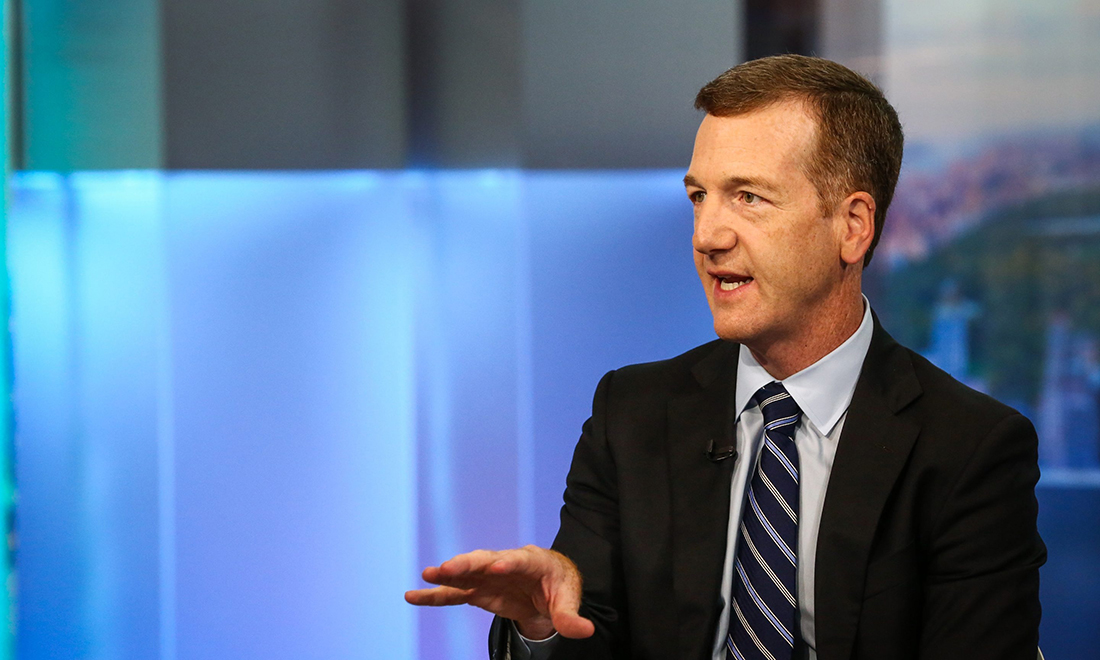
美国股市结束低迷的2022年之后大幅上涨,但摩根士丹利(Morgan Stanley)的迈克·威尔森认为,股市进入了“大起大落”的过程。
作为摩根士丹利的首席美国股票策略师,威尔森在周末的一篇报告中对客户表示,虽然美国政府的支出曾支撑过股市和经济发展,但未来可能给股市带来麻烦。
他表示:“对于今年的股票市场而言,主要收获是财政政策使美国经济增长速度超出预期,使各界普遍认为经济衰退的风险大幅下降。”他还表示,随着最近债务上限被取消,这个趋势会持续到2025年。
即使面临美联储快速收紧货币政策,美国经济依旧韧性十足。然而,长期财政刺激可能扩大政府赤字,这是上周惠誉(Fitch)下调美国信用评级的原因之一。
美国政府称,财政开支“保证了美国人民的福祉”,拜登政府将GDP增长和通胀降温作为证明其经济政策卓有成效的证据。
威尔森在机构投资者(Institutional Investor)去年的调查中,凭借预测股市暴跌被排在策略师排名的第一位。他认为,财政支出与美国的失业率相比显得尤其“过度”。上个月,美国的失业率只有3.5%。
他还警告,上周美国政府债券下跌可能对股市造成负面影响。政府债券是支持财政开支的资金来源。
他预测,投资者会对股票估值产生质疑。他还表示:“如果因为更高政治或融资成本,导致政府不得不削减财政支出,那么从去年开始尚未平息的收益下降问题,更有可能会卷土重来。”
“大起大落”的风险
周一,在接受彭博社采访时,威尔森重申了他的担忧。他认为,美国政府可能在太短时间内动用了太多财政资金,这最终可能会影响到股市的估值。
他表示:“从这个角度来看:当美国的失业率为3.5%的时候,美国政府的预算赤字支出为8%,这真得史无前例。如果今年美国经济增速下滑,会发生什么? [这就是为什么]我认为这种大起大落的理论是正确的。”
标普500指数中包含了许多全世界规模最大的公司。2022年,标普500指数经历了自金融危机以来最低迷的一年,今年到目前为止该指数上涨了约20%。
虽然许多华尔街巨头基于今年该蓝筹股指数的反弹,大幅提高了对该指数的价格目标,但威尔森却反其道而行,坚称“熊市仍未结束。”
他对彭博社表示:“或许市场有不同预期,但考虑到当前的市场估值,这种观点存在风险。去年秋天买入股票是好主意,我们进行了交易,但持有时间不够长,但我认为在当前这个阶段,你需要非常慎重地挑选股票,至少要选择一些重新回到200日移动平均线的投资。”
标普500指数的200天移动平均线约为4,100点,比该指数当前的水平低约10%。
威尔森并非唯一一位对政府增加干预的影响提出警告的银行业者。
上个月,摩根大通(JPMorgan)CEO杰米·戴蒙在接受《经济学人》采访时,被问到他是否认同拜登经济学,即拜登政府制定的通过增加联邦政府支出刺激经济增长的一系列政策。
他说道:“我认为,如果有人针对未来10年写书,肯定有很大篇幅介绍这个十年如何失败,抨击它的效率低下,公司获利丰厚,与Solyndras破产类似的悲剧再次发生,因此我会警告人们可以投资股市,但必须非常慎重。”
熊市预测
作为华尔街知名度最高的空头之一,威尔森对美国股市一直给出悲观预测。他在5月警告,不要被标普500指数的反弹所欺骗。
今年早些时候,他预测美国股市即将下跌20%,并在最近分析了为什么他的预测没有成真。
他在上个月的客户报告中承认:“我们错了。2023年,在通胀下降和成本降低的大环境下,股市估值上涨。”
在周一接受彭博社采访时,威尔森表示他“本应该相信自己的直觉”,在1月份修改他的修改预测。当时,他担心摩根士丹利的前景预测过于悲观。
他说道:“我们没有考虑到财政刺激措施的影响,这是一个严重错误。我们以为[政府]会在真正需要的时候出台财政刺激政策。”
目前,他对2024年6月的基本情景预测是,标普500指数下跌至约4,200点,较当前水平下跌7%。
但在悲观情景下,他预测该蓝筹股指数将下跌至3,700点,这意味着要比当前的水平下跌约20%。(财富中文网)
翻译:刘进龙
审校:汪皓
美国股市结束低迷的2022年之后大幅上涨,但摩根士丹利(Morgan Stanley)的迈克·威尔森认为,股市进入了“大起大落”的过程。
作为摩根士丹利的首席美国股票策略师,威尔森在周末的一篇报告中对客户表示,虽然美国政府的支出曾支撑过股市和经济发展,但未来可能给股市带来麻烦。
他表示:“对于今年的股票市场而言,主要收获是财政政策使美国经济增长速度超出预期,使各界普遍认为经济衰退的风险大幅下降。”他还表示,随着最近债务上限被取消,这个趋势会持续到2025年。
即使面临美联储快速收紧货币政策,美国经济依旧韧性十足。然而,长期财政刺激可能扩大政府赤字,这是上周惠誉(Fitch)下调美国信用评级的原因之一。
美国政府称,财政开支“保证了美国人民的福祉”,拜登政府将GDP增长和通胀降温作为证明其经济政策卓有成效的证据。
威尔森在机构投资者(Institutional Investor)去年的调查中,凭借预测股市暴跌被排在策略师排名的第一位。他认为,财政支出与美国的失业率相比显得尤其“过度”。上个月,美国的失业率只有3.5%。
他还警告,上周美国政府债券下跌可能对股市造成负面影响。政府债券是支持财政开支的资金来源。
他预测,投资者会对股票估值产生质疑。他还表示:“如果因为更高政治或融资成本,导致政府不得不削减财政支出,那么从去年开始尚未平息的收益下降问题,更有可能会卷土重来。”
“大起大落”的风险
周一,在接受彭博社采访时,威尔森重申了他的担忧。他认为,美国政府可能在太短时间内动用了太多财政资金,这最终可能会影响到股市的估值。
他表示:“从这个角度来看:当美国的失业率为3.5%的时候,美国政府的预算赤字支出为8%,这真得史无前例。如果今年美国经济增速下滑,会发生什么? [这就是为什么]我认为这种大起大落的理论是正确的。”
标普500指数中包含了许多全世界规模最大的公司。2022年,标普500指数经历了自金融危机以来最低迷的一年,今年到目前为止该指数上涨了约20%。
虽然许多华尔街巨头基于今年该蓝筹股指数的反弹,大幅提高了对该指数的价格目标,但威尔森却反其道而行,坚称“熊市仍未结束。”
他对彭博社表示:“或许市场有不同预期,但考虑到当前的市场估值,这种观点存在风险。去年秋天买入股票是好主意,我们进行了交易,但持有时间不够长,但我认为在当前这个阶段,你需要非常慎重地挑选股票,至少要选择一些重新回到200日移动平均线的投资。”
标普500指数的200天移动平均线约为4,100点,比该指数当前的水平低约10%。
威尔森并非唯一一位对政府增加干预的影响提出警告的银行业者。
上个月,摩根大通(JPMorgan)CEO杰米·戴蒙在接受《经济学人》采访时,被问到他是否认同拜登经济学,即拜登政府制定的通过增加联邦政府支出刺激经济增长的一系列政策。
他说道:“我认为,如果有人针对未来10年写书,肯定有很大篇幅介绍这个十年如何失败,抨击它的效率低下,公司获利丰厚,与Solyndras破产类似的悲剧再次发生,因此我会警告人们可以投资股市,但必须非常慎重。”
熊市预测
作为华尔街知名度最高的空头之一,威尔森对美国股市一直给出悲观预测。他在5月警告,不要被标普500指数的反弹所欺骗。
今年早些时候,他预测美国股市即将下跌20%,并在最近分析了为什么他的预测没有成真。
他在上个月的客户报告中承认:“我们错了。2023年,在通胀下降和成本降低的大环境下,股市估值上涨。”
在周一接受彭博社采访时,威尔森表示他“本应该相信自己的直觉”,在1月份修改他的修改预测。当时,他担心摩根士丹利的前景预测过于悲观。
他说道:“我们没有考虑到财政刺激措施的影响,这是一个严重错误。我们以为[政府]会在真正需要的时候出台财政刺激政策。”
目前,他对2024年6月的基本情景预测是,标普500指数下跌至约4,200点,较当前水平下跌7%。
但在悲观情景下,他预测该蓝筹股指数将下跌至3,700点,这意味着要比当前的水平下跌约20%。(财富中文网)
翻译:刘进龙
审校:汪皓
U.S. stocks have skyrocketed since their dreary end to 2022—but Morgan Stanley’s Mike Wilson is convinced equities are in a “boom-bust” position.
Wilson, the company’s chief U.S. equity strategist, told clients in a weekend note that while U.S. government spending had helped prop up markets and the economy, it could be setting equities up for problems further down the line.
“The main takeaway for the equity market this year is that fiscal policy has allowed the economy to grow faster than forecast, giving rise to the consensus view that the risk of a recession has faded considerably,” he said, adding that with the recent lifting of the debt ceiling this could continue until 2025.
The U.S. economy has remained resilient even in the face of rapid monetary tightening by the Federal Reserve. However, prolonged fiscal stimulus would widen the government deficit—one of the concerns flagged by Fitch when it downgraded America’s credit rating last week.
The government says its spending has “ensured the wellbeing of the people of the United States,” with the Biden administration touting GDP growth and cooling inflation as proof that its economic policies have worked.
Wilson——who was ranked No. 1 in last year’s Institutional Investor survey after correctly predicting the selloff in stocks—noted however that fiscal spending appeared particularly “excessive” when compared to the U.S. unemployment rate, which stood at just 3.5% last month.
He also flagged that last week’s selloff of government bonds—which fund fiscal expenditure—would have consequences for the stock market.
Investors will call into question equity valuations, he predicted, adding: “If fiscal spending must be curtailed due to higher political or funding costs, the unfinished earnings decline that began last year is more likely to resume.”
‘Boom-bust’ risk
In an interview with Bloomberg on Monday, Wilson reiterated his concerns that the U.S. government may be using too much of its fiscal ammunition too soon, which could ultimately dampen stock valuations.
“Think about it this way: they’re doing 8% budget deficit spending when you have 3.5% unemployment—that’s really unprecedented,” he said. “So, what’s going to happen if we do have a slowdown next year? [That’s why] I just think this boom-bust thesis is so correct.”
The S&P 500, which is home to some of the world’s biggest companies, is up almost 20% so far this year after suffering its worst year since the financial crisis in 2022.
And while many Wall Street giants have been drastically raising their price targets for the blue chip index on the back of its rally this year, Wilson has refused to follow suit and insisted that “the bear is still alive.”
“Maybe the markets are looking through it to the to the other side—[but] that’s a risky proposition, given where valuations are,” he told Bloomberg. “It was a great idea to buy stocks last fall, we traded it, we didn’t stick with it long enough, but I think at this stage you need to be very selective for some sort of retracement at least back to the 200-day moving average.”
The S&P 500’s 200-day moving average currently stands at around 4,100 points—almost 10% lower than where the index itself is trading.
Wilson isn’t the only big-name banker to warn about the impact of increased government interventions.
In an interview with The Economist last month, JPMorgan CEO Jamie Dimon was asked whether he approved of Bidenomics—a raft of policies rolled out by the Biden administration that have involved increasing federal spending in a bid to boost economic growth.
“I think when they write books about this 10 years from now, a lot is going to be about how it didn’t work, [it was] ineffective, companies feeding at the trough, Solyndras taking place again, so I would caution people, yes, do it, but be really careful,” he said.
Bearish predictions
Wilson, one of Wall Street’s most prominent bears, has long been making gloomy predictions about U.S. stocks, warning investors in May not to be fooled by the S&P 500 rally.
Earlier this year, he predicted that a 20% downturn was imminent for U.S. stocks—and has recently reflected on why his projections missed the mark.
“We were wrong,” he conceded in a note to clients last month. “2023 has been a story of higher valuations amid falling inflation and cost cutting.”
In Monday’s interview with Bloomberg, Wilson said he “should have gone with his instinct” and revised his market calls in January when he feared that Morgan Stanley’s outlook was too bearish.
“We missed this fiscal impulse, that was a big mess on our part,” he said. “We thought the fiscal impulse would come at the time that [the government] really needed it.”
His base case for June 2024 is now for the S&P 500 to drop to around 4,200 points—a drop of just 7% from current levels.
In a bear case scenario, however, he has forecast that the blue-chip index could plummet as low as 3,700, meaning they would shed almost 20% from where they are now.






